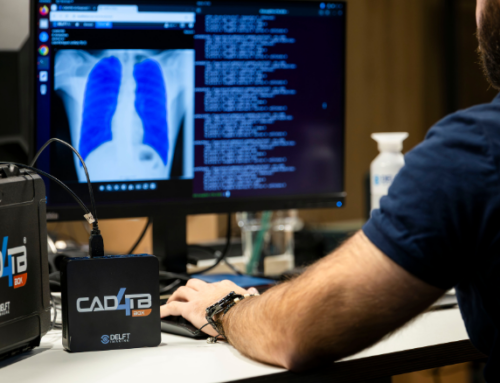In a recent Delft webinar, Julius Tumwine, the team lead at LabXpertDS and the Connectivity focal person for NTLP Uganda presented a compelling case of how Uganda is integrating digital connectivity solutions to streamline TB diagnostics. He emphasised the pivotal role of linking X-ray screening with CAD4TB and laboratory diagnostics, providing a comprehensive approach to managing and combating tuberculosis.
The Importance of Connectivity in TB Diagnostics
As a nation grappling with a high TB burden, Uganda has significantly invested in connectivity solutions to improve TB diagnostics. These investments focus on the digital transmission, aggregation, and processing data from various diagnostic instruments. The main objectives are facilitating real-time performance monitoring, troubleshooting, and efficient patient result management.
The WHO and Uganda’s NTLP prioritise these connectivity solutions to ensure that molecular WHO-recommended rapid diagnostics testing sites can electronically transmit results to clinicians, patients, and the Ministry of Health (MoH). Julius Tumwine highlighted the significance of these investments, stating, “A significant investment has been made in all TB disease-burdened countries in connectivity recently. These connectivity solutions would help us in sending, aggregating, and processing data from multiple instruments that are used in the laboratory. And this can help us in monitoring performance instrument networks in real-time, troubleshooting the utilisation of the instruments, looking at reagents and forecasting stock, and also looking at the results for patient management.”
Introducing LabXpert
At the heart of these connectivity efforts is the LabXpert platform, a web-based system designed to support automated data capture from multiple diagnostic instruments, including GeneXpert, TrueNat, Afinion, and digital X-ray machines. LabXpert offers key functionalities, such as monitoring equipment utilisation and functionality, managing inventory and stock levels, and providing real-time reporting and feedback through automated data capture. Tumwine explained the value of LabXpert, noting, “LabXpert supports monitoring of equipment utilisation, equipment functionality, inventory management, stock levels, and linkage of patients to treatment through sending alerts to patients and clinicians.”
Additionally, LabXpert sends alerts to patients and clinicians to link them to treatment promptly. One particularly noteworthy capability of LabXpert is its ability to relay results via SMS, significantly reducing turnaround times, especially for samples from lower-level facilities to central laboratories.
Integrating X-ray Screening with Laboratory Diagnostics
A crucial feature of the LabXpert system is its integration with CAD4TB to link X-ray screening results with laboratory diagnostics. This process involves several steps:
- Unique Patient Identifiers: Each patient receives a unique identifier generated from a lab information management system, patient management system, or barcode. The patient identifiers and related information are uploaded to LabXpert. If there is no internet connection during data capture, the results sync automatically once connectivity is restored.
- Sample Identification: Samples sent to the lab have the patient identifier attached. Lab technicians use this identifier as the specimen ID in the diagnostic equipment.
- Result Integration: Test results are uploaded to LabXpert, which automatically matches the X-ray and laboratory identifiers to provide a comprehensive result for the patient.
Tumwine elaborated on this integration: “LabXpert automatically matches the two identifiers (X-ray and lab) to provide a comprehensive result for the patient.”
Demonstrating LabXpert
During the webinar, Tumwine showcased several LabXpert features—the X-ray portal lists all connected X-ray devices and their last upload times, accommodating intermittent internet connectivity. Patient scores and clinical information from CAD4TB are displayed, providing administrators with an online backup and centralised access. The platform also allows for periodic analysis and comparison of images to ensure diagnostic consistency with remote analysis capabilities for non-TB-related images.
LabXpert generates reports showing screening counts and score thresholds, identifying misuse of equipment, and consolidates CAD4TB scores, lab results, X-ray sites, and dates in one view, providing clinicians with comprehensive patient information. The system tracks the time from screening to lab result acquisition for performance improvement and predicts equipment maintenance needs using AI models, ensuring continuous operation.
The Impact and Benefits
Integrating CAD4TB with LabXpert yields significant benefits:
- Reduced Turnaround Times: Faster diagnostic results and treatment initiation.
- Enhanced Equipment Utilization: Better monitoring and managing of diagnostic instruments.
- Comprehensive Patient Management: Consolidated data providing a complete picture for clinicians, improving patient care.
- Real-Time Monitoring: Enhanced overall efficiency of TB diagnostics through real-time data collection and feedback mechanisms.
Tumwine summarised the impact, stating, “This can help us in monitoring performance instrument networks in real-time, troubleshooting the utilisation of the instruments, looking at reagents and forecasting stock, and also looking at the results for patient management.”
Conclusion
Julius Tumwine’s presentation highlighted the transformative impact of connectivity solutions like LabXpert and CAD4TB in the fight against TB in Uganda. By linking X-ray screening with laboratory diagnostics, these technologies offer a robust framework for real-time data integration, equipment monitoring, and comprehensive patient management.
By integrating CAD4TB with LabXpert, Uganda is paving the way for a more efficient, accurate, and comprehensive TB detection and management approach. This innovative use of AI-powered assistance and digital health technology sets a new standard for TB care in low-resource settings.



